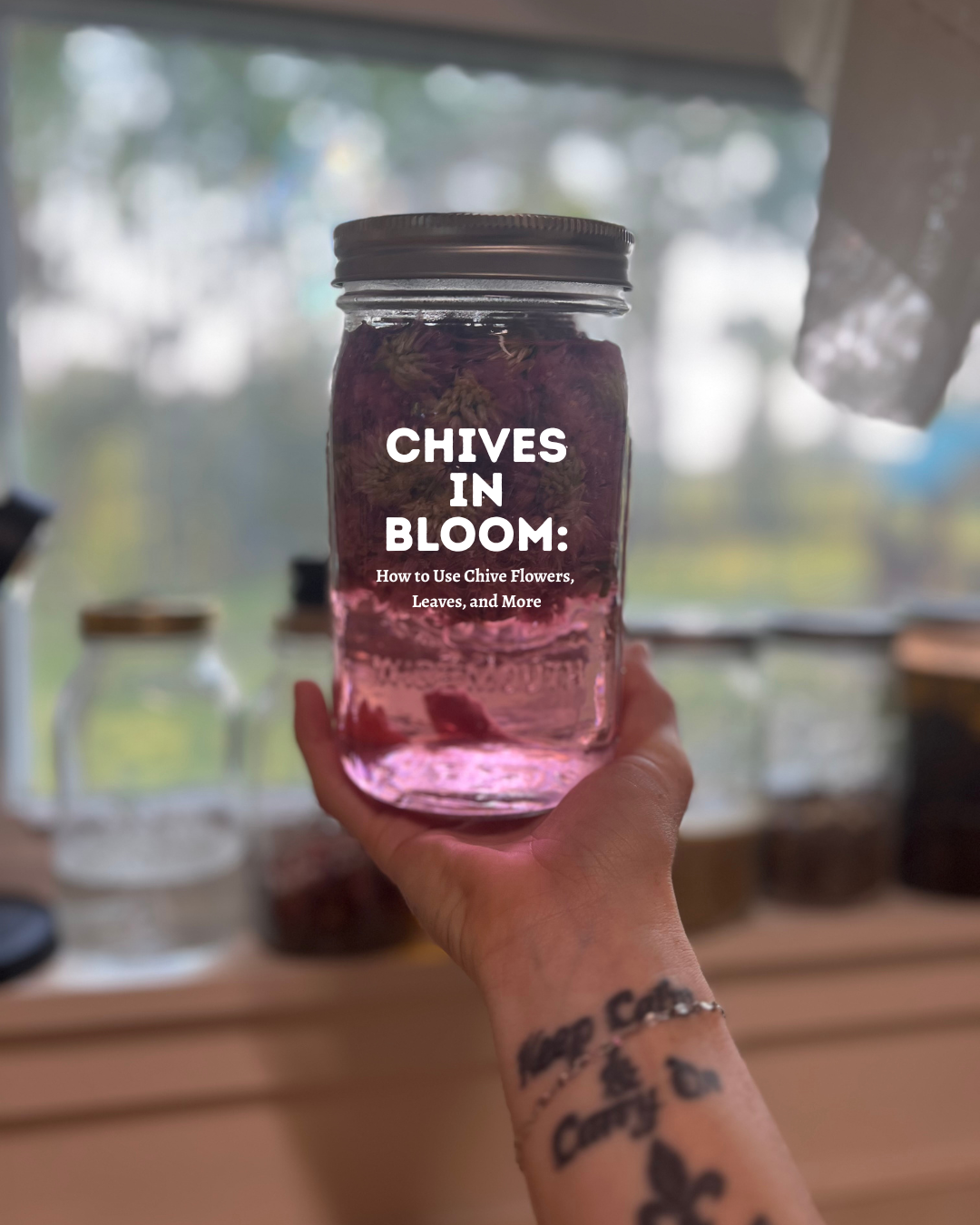
Chives are one of the easiest herbs to grow—and one of the most overlooked when it comes to their flower power. Not to mention BEAUTIFUL. Be sure to look closely at these stunning flowers as they are tons of mini flowers within a flower. These hardy perennials not only bring fresh, onion-like flavor to your kitchen, but they also burst into beautiful, edible purple blossoms that are as versatile as they are stunning.
Whether you're snipping fresh leaves for a savory dish or steeping their pom-pom flowers in vinegar, chives deserve a permanent place in your garden and apothecary kitchen.
This blog post was inspired by a conversation with my mom and my neighbor! Thanks ladies.
🌸 The Magic of Chive Flowers
In late spring to early summer, chive plants (Allium schoenoprasum) send up globe-shaped purple blooms that are completely edible. Their flavor is similar to the leaves—mildly oniony with a floral, slightly garlicky edge.
Use them to:
-
Add color to salads or grain bowls
-
Garnish savory dishes like quiche, frittatas, or dips
-
Infuse into vinegar or honey for functional, flavorful creations
-
Dry for decorative use or homemade herbal blends
🧪 Chive Flower Vinegar (Beautiful + Tangy)
A pantry (and Pinterest) favorite, chive flower vinegar turns the most gorgeous shade of pink and adds depth to dressings, marinades, and more. My mom made this for me this week! The color is beautiful.
You’ll need:
– 1 cup fresh chive blossoms (rinse & pat dry)
– 1–1.5 cups raw apple cider vinegar or white vinegar (we used white)
– 1 clean glass jar with lid
To make:
-
Pack clean blossoms loosely into the jar.
-
Pour vinegar over until fully submerged.
-
Cover and store in a cool, dark place for 1–2 weeks.
-
Strain and store in a clean bottle. Use on everything!
🍯 Chive Blossom Honey (Savory-Sweet Goodness)
Perfect for cornbread, grilled cheese, roasted veggies, or sore throats with a kick. Im making this today!
You’ll need:
– 1/2 cup chive blossoms
– 1 cup raw honey
– 1 small clean jar
To make:
-
Add dry chive flowers to your jar.
-
Pour honey over to cover completely.
-
Let infuse for 5–7 days (or up to 2 weeks) in a cool place.
-
Strain and store. (Or leave flowers in for visual flair!)
🌿 Using & Preserving Chive Leaves
Chive leaves bring a subtle, oniony flavor to just about anything. Think of them like green onions, but softer and more delicate.
Use fresh in:
– Herb butters
– Scrambled eggs and omelets
– Dips, dressings, and potato salad
– Savory scones or biscuits
– Broths and soups (stir in last)
To dry chives for later:
-
Harvest early in the day (before flowers open).
-
Wash and dry thoroughly.
-
Chop and lay in a single layer on a screen or paper towel in a cool, dry area.
-
Once crisp, store in an airtight jar away from sunlight.
Wild Tip: Dried chives lose some of their fresh punch, but are excellent in salt blends, seasonings, and dry soup mixes.
🧄 Bonus: Make a Chive Flower Compound Butter
Ingredients:
– 1/2 cup softened butter
– 2 tbsp chopped chive leaves
– 1 tbsp chive blossoms, separated
– Pinch of sea salt
To make:
Mix everything until smooth. Chill in a log or mold. Spread on warm bread, toss into veggies, or melt over grilled meat.
Why We Love Chives
-
Perennial + Pollinator Friendly: Comes back year after year and supports bees when in bloom
-
Dual-Use: You get both edible leaves and flowers
-
Easy to Grow: Thrives in pots, beds, or tucked in the garden border
-
Preservable: Perfect for drying, freezing, and infusing
- Beyond their culinary charm, chives (Allium schoenoprasum) offer a range of gentle medicinal properties rooted in the same plant family as garlic and onions. Traditionally used to support digestion, stimulate appetite, and gently detoxify the body, chives carry natural antibacterial and anti-inflammatory compounds. Their mild sulfur content may help support the immune system, while their antioxidants offer gentle cardiovascular benefits. Though not as potent as garlic, chives are a nourishing, everyday way to bring plant-powered wellness into your meals—one snip at a time.
In Closing…
Chives are a simple herb with surprising magic—especially when they’re in bloom. Whether you’re crafting a pink-tinged vinegar, a savory infused honey, or snipping them fresh from your garden into dinner, they invite us to slow down and savor what’s in season.
Want more garden-to-kitchen inspiration?
Make sure you're signed up for our Wildly Botanical newsletter & check out our newest seasonal products online!